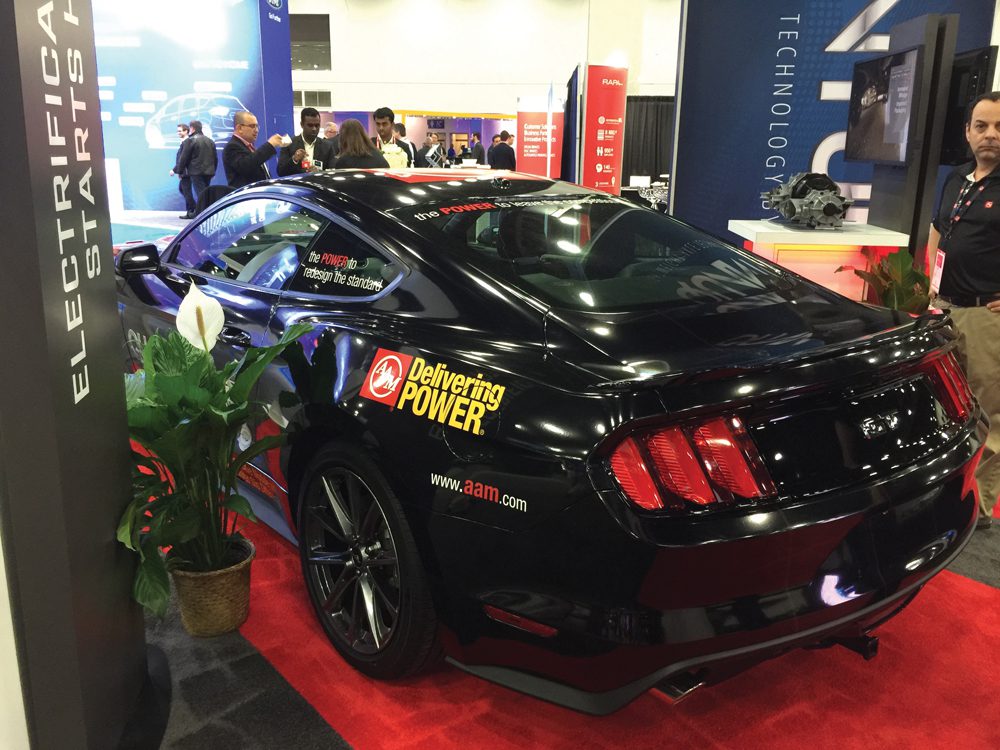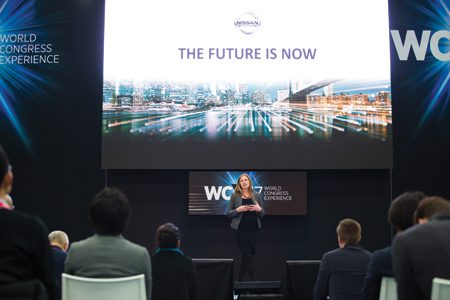

Automotive engineers and other technologists with a keen eye for what the future holds, especially as automakers look at the transformation of the industry in ways that include electrification and replacing drivers with sensors and software, gather annually for SAE International’s World Congress.
Those three days earlier this year—April 4-6—were heralded as a rebranded World Congress Experience (WCX).
At Cobo Center in Detroit, the gathering offered more than a glimpse into what consumers can expect to see in the months and years ahead.
The two major thrusts forward for the industry remain the electrification of the automobile and the self-driving car—autonomous being the technical term most often used for the latter—and both were spoken about in volumes throughout WCX.
That said, electrification is mostly considered a given, with the technology firmly in place to build momentum.
Industry keeping options open
As far as the future of autonomous driving is concerned, the industry is continuing to not only innovate, but to experiment with various approaches, while keeping its options open as corporate alignments are formed, acquisitions are made and markets—sometimes “guided” by governments trying to stay ahead of the curve—play a role in whatever shape the driverless car ultimately takes.
Even so, few are disputing the idea that autonomous driving is inevitable, one oft-cited reason being that fewer deaths—some 40,000 died on U.S. roads in 2016—will result, especially given that 94 percent of accidents were said to be caused by human error.
At WCX, a series of roundtable discussions with industry notables included one with Anthony Foxx, the former Secretary of Transportation under President Barack Obama, who released the Federal Automated Vehicles Policy in September 2016.
That guidance helped set the stage for what automakers can at least anticipate in terms of regulations for the first new form of transportation introduced since the Department of Transportation was created half a century ago.
Foxx said the policy guidelines his department released “lay a good foundation describing what the industry can do moving forward, in particular around issues of privacy and cyber security.”
Acknowledging that the race to a world of autonomous driving is one that has highly competitive overtones, Foxx said having a common understanding of what will be required to operate and maintain systems that are sufficiently secure will be key.
“Without a common understanding of what that means, there’s a risk to the category itself,” said Foxx.
Those two issues aside for a moment, there are clearly a combination of social imperatives, including how quickly markets will embrace changes like those inherent in electrification and autonomous driving (think charging stations and the pressure on an already strained grid with higher percentages of electric vehicles on the road, and issues such as insurance—a state-by-state issue—when considering driverless cars).
But where does the pace of technology innovation appear to be taking us? And what could possibly slow that pace?
To answer those questions, it’s important to tackle the two main topics—electrification and autonomous driving—separately.
With electrification, what drives innovation is a combination of cost and efficiency, the latter measured by government mandated mileage standards.
Taking a ‘holistic’ approach with electric
It’s here that experts like Paul Eichenberg, a former automotive executive and now an industry growth, turnaround and performance expert, makes the point that an electrified vehicle offers “holistic” benefits going forward, particularly when the idea of driverless cars, especially in service as taxis and the like, takes hold.

“There’s less maintenance required with electric vehicles and when people talk about advanced mobility, which is where the market is shifting to, the kind of autonomous operation becomes much more compatible with an electric platform. For those reasons, it’s widely understood that those kinds of vehicles will be electric.”
Even aside from the connection between electrification and autonomous drive, Eichenberg believes there will be more regulation globally—in spite of any rollback of standards in the U.S.—not less.
And that will mean more electrics on the road, if for no other reason than the fuel economy standards will almost certainly demand it.
In Europe, for example, automakers will need to hit a fuel efficiency of 56.2 miles per gallon by 2020, five years ahead of the 54 mpg the U.S. has called for by 2025.
Getting to those numbers, on either side of the Atlantic, will require significant improvements in the technology associated with the internal combustion engine, an area where European-based companies are already ahead of the U.S.
The cost—which will drive profitability and the sustainability of companies to deliver on the technology required to deliver the targets—is said to be about $250 per vehicle.
But Eichenberg predicts that going to the next round of European legislation, which calls for an equivalent rating of 73 mpg, will add another $1,500 per vehicle using internal combustion technology.
“We’re starting to reach the limits of stand-alone internal combustion engine technology,” says Eichenberg. “Basically the only way you are going to be able to improve in a cost-effective manner is by having a higher level of hybrid and electrification in the market.”
Eichenberg says the 10 years beginning in 2020 will be the decade of electrification and not just for companies like Tesla. “Vehicle electrification will come faster than many currently anticipate and the adoption rate will be much higher than most are predicting.”
One reason for his optimism is that the cost per kilowatt hour, the measure of efficiency in a battery pack, has dropped (from several hundred dollars to less than $200) and is likely to fall much further based on technology and manufacturing efficiencies.
Change is being driven by regulations
Automakers, particularly in Europe, are embracing electrification as a way to meet much stricter government standards and that is having a ripple effect elsewhere.

Add to the equation the fact that China—the world’s largest market—has dictated an increasingly significant percentage of vehicles sold there will be zero emission, which includes battery or fuel cell technology.
“The trend globally is not reversible, despite what the Trump administration may be saying,” says Eichenberg, who adds that numerous conversations with industry experts suggest about 14 percent of the global market by 2030 will be battery electric vehicles.
The other consideration related to electrification is that of scale—the industry’s capability to support, from a manufacturing and technological standpoint, those higher volumes of electric vehicles.
“Electronic parts, in an industrial sense, scale differently than those that go into traditional mechanical components, which are the basis for the traditional motor vehicle,” says Eichenberg.
Here he points to the fact that 60 percent of the cost of an electric drive motor is related to rare earth magnets and copper, meaning that in order for a manufacturer to be competitive, it will require those basic materials in significant volumes.
Consider that GM’s major partner for the all-electric Chevy Bolt is LG Group of South Korea, a major supplier not only of the lithium ion batteries, but the motors and power electronics.
What that spells out, says Eichenberg, is an ongoing disruption in the automotive industry, one that’s almost certain to continue as electrified vehicles rise in volume and as a percentage of the total number of vehicles worldwide.
Back to SAE’s WCX, discussions around the future of autonomous drive focused around some of the requirements that will need to be commonplace if the market is to see dramatic rates of implementation.
For people like Sherif Murakaby, vice president of Global Vehicle Programs at Uber, the successful transportation network company, the trajectory for the self-driving car will include a number of technologies, although not so different from what exists today.
Murakaby, who spoke at a roundtable on the effects of automated technology, said technologies grouped as ADAS—Advanced Driver Assistance Systems—including adaptive cruise control, automatic parking, collision avoidance systems and lane departure warning systems to name a few—will continue to be featured prominently in the march to autonomous drive.
“Those technologies are already here,” said Murakaby. “ADAS uses the same building blocks, the same sensing technologies that would be used for autonomous vehicles, just advanced generations of those.”
Market will demand advanced features
Pat Bassett, vice president of Engineering at DENSO International America, Inc., and a co-panelist with Murakaby, said he believes the market will demand the features of ADAS. “We had over 30,000 deaths in the U.S. last year and having those is going to make your products more attractive.”

While not specifically mentioned as part of the WCX panel, Paul Eichenberg says there is a need for a standardized way for vehicles to communicate, not just with one another but with various forms of infrastructure, including traffic signals and even the road itself.
“The only way that it becomes a fully efficient network is when every vehicle is communicating to every other vehicle, as well as with infrastructure like stoplights and railroad crossings,” said Eichenberg. “It’s when cars start to understand the intent of other vehicles before their drivers do that the real value is created.”
The concept Eichenberg describes is called V2X—for Vehicle to “Everything Else”—and while the federal government is still in the process of introducing regulations, there appears to be momentum building for a standard to be identified.
While the regulatory wheels may grind slowly, they are turning.
That said, one of the key questions is whether the direction those regulatory wheels are turning is the right one, at least from a technology standpoint.
Consider for a moment the current reality: that the National Highway Traffic Safety Administration has identified a proposed standard for communication between vehicles and infrastructure—the 802.11p wireless standard, which uses a radio frequency of 5.9 GHz.
At the same time, however, the industry (including players like Qualcomm, Intel and others) are actively developing 5G technology as better, more robust and—especially important—more “data friendly,” a critical element when it comes to the kind of machine learning that would allow vehicles to benefit “on the fly” from data they’re getting from other vehicles on the road.

Eichenberg says a factor in how quickly the ultimate standard for V2X technology is identified and agreed upon will drive the rate of widespread adoption of autonomous vehicles.
The 5G path would also play into another potential game changer when it comes to the ongoing development of a world where self-driving cars are commonplace and well accepted.
That applies to the idea that the software essential to a vehicle with autonomous capabilities could be updated “over the air”—through cellular technology like 5G.
It’s how Tesla currently updates software on its vehicles, making possible for it to correct a problem it had in 2013, with vehicles operating with its selectable suspension system in “low” setting sometimes scraping the ground, clearly an undesirable situation.
Tesla sent a software update to its vehicles, disabling the “low” setting at highway speed.
Problem fixed.
Moving on, another technical aspect that must be achieved in an autonomous vehicle is creating the advanced electrical systems that will support the electronics needed. That means a shift from 12-volt and 24-volt systems to 48-volt, a significant step requiring fundamental change to a vehicle’s systems configuration.
The subject of how existing systems, especially in urban areas with well-developed transit service, will be impacted by the advance of autonomous vehicles and/or ride sharing is also something that transportation planners are at least thinking about.
Anthony Foxx, in his discussion with WWJ Radio’s Jeff Gilbert, said as much when asked to comment about a possible reinvention of that sector.
“There will be disruption—good disruption—in public transit,” said Foxx. One consideration is that the integrated involvement of various ride sharing services with transit agencies will require every piece of the overall service to be compliant with the Americans with Disabilities Act, ensuring access.

“That will require the ride share community to think about how they do what they do,” said Foxx.
So when are U.S. consumers likely to see these kind of vehicles—electric and autonomous in the variations automakers and tech firms like Uber and the like are envisioning—in significant numbers on the road?
That is certainly a question for which there are no clear answers. At least not right now.
But when the former U.S. Secretary of Transportation was asked for his opinion on when the “era of autonomous drive” will begin, Anthony Foxx’s answer was, if not surprising, perhaps encouraging to those who look forward to having new choices when it comes to access to mobility.
“I think it’s begun,” he said. “I can’t trace it back to any one point, but my marker might be when we presented the [autonomous vehicle] guidelines. The question it’s raising is how disruptive it will be. Think about it from the point of view of a conventional OEM who’s been selling to consumers for years. To what extent is this consumer led or business led change?”
And as far as the rate of change, Foxx offered an opinion that must surely giving pause to automakers worldwide.
“I’m not sure I’ll be buying another car,” he said. “It might be a ride-sharing service, but there are going to be lots of options out there.”








